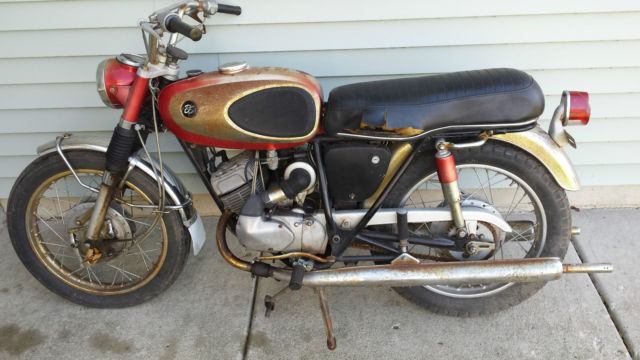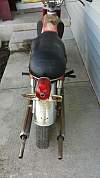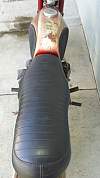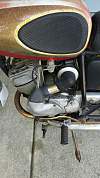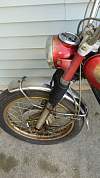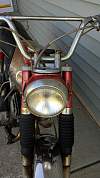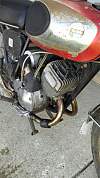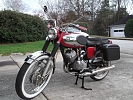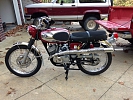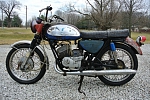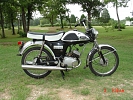1967 bridgestone 175 twin hurricane and 1967 175 twin scrambler
1967 Other Makes bridgestone 175 twin hurricane
| Price: | US $202.50 |
| Item location: | Genoa City, Wisconsin, United States |
| Make: | Other Makes |
| Model: | bridgestone 175 twin hurricane |
| SubModel: | scrambler |
| Type: | Dual-Purpose |
| Year: | 1967 |
| Mileage: | 1,000 |
| Color: | Red |
| Engine size: | 175 |
| Vehicle Title: | Salvage |
| Contact seller: | Contact form |
Description
So with this auction you will get1. running off of spray 1967 twin hurricane2.1967 175 twin scrambler hurricane
Bridgestone's 175 Hurricane Scrambler is a logical development of the 175cc "Dual Twin" touring machine the company introduced a couple of years ago. More and more, otorcyclists look to the woods for riding fun, nd for safety from the the hordes of automobiles that clutter the nation's highways. Today's motorcyclist, n many if not the majority of instances, ants a bike he can use either on pavement or out on little-used trails. It need not be a full-fledged scrambler; that would make the bike impractical for street riding. The basic requirement is for a highway machine, ith modificatios to give it added power, tc. And that is a pretty good capsule description of the Bridgestone Hurricane Scrambler.In the "scrambler," as was and is true of the pure touring Bridgestone 175, he engine is the most interesting feature. This engine, hich is packed with little items that should delight the technically inclined, as the first mass-produced two-stroke "twin" to have rotary-disc inlet valves. Most such engines have nothing more elaborate than a hole in the back of each cylinder. When the piston skirt's lower edge comes up and clears the hole, he mixture is drawn into the crankcase. Similarly, he piston skirt closes the port when it comes back down. A great system from the standpoint of simplicity, ut not without its drawbacks. For one thing, here is a tendency for the charge drawn into the engine to escape again as the piston moves back down. This can be countered, o a very large extent, y adjusting the size and timing of the intake port. But it can only be adjusted to work well over a limited range.A disc-type rotary valve is much less handicapped. By using this device, n engine designer can get any opening and closing points needed for the intake period. As a result, he power range will always be a bit wider, or any given level of output, hen rotary valves are used. You may not care about the technical ins and outs of the matter, ut you will care about the engine's wide-range pulling power.Another point that will, ooner or later, e of some importance to the buyer is that the Bridgestone engine comes apart and goes back together in rapid, ip-zip fashion. The mechanic, own at your local dealer's shop, an do even a total overhaul very quickly, nd the labor charges account for a large part of such repair bills.There are reasons, oo, hy the frequency of repairs should be low. The Bridgestone engine, ike most modern two-strokes, as its crankshaft running in ball bearings, ith caged rollers at the connecting-rod big-ends. Up at the piston-pin ends of the connecting rods, here are caged needle-roller bearings, nd we consider this important. Piston-pin bearings, n two-stroke engines, re rather poorly lubricated. To make matters even worse, hey are subjected to high temperatures. The plain bushings once universally used, nd still found in some engines, o not like the combination of heat and scanty lubrication. They wear rapidly, nd when worn they clatter and cause a lot of internal unpleasantness. Needle-rollers, ike those in the Bridgestone, o a lot for reliability.General over-heating and an occasional piston seizure has also, n the past, een something of a problem with high-output two-stroke engines. There are various ways in which designers have overcome such problems. Bridgestone uses a very direct method. Aluminum is a material that transfers heat (as from a cylinder to air) particularly well, o they have simply made the entire cylinder out of aluminum. As in the case of the rotary valves, ll-aluminum cylinders with hard-chrome plated bores had been developed in racing; Bridgestone was the first to apply this to a touring motorcycle. These cylinders "cool" very efficiently, nd as they expand at the same rate as the aluminum pistons, eizures will not occur unless something is dreadfully wrong.Like most modern two-strokes, he Bridgestone engine is fitted with an automatic oiling system. A small variable-delivery pump, ngine driven, njects oil into theintake air-stream just behind the carburetor. This keeps the intake valave disc and its chamber well lubricated, nd the oil manages somehow to find its way around to the various bearings. It all seems a trifle haphazard, ompared to piping the oil directly to the bearings, ut it works about as well as the traditional oil-in-fuel mixtures and it relieves the owner of the measuring/mixing chore.Rapid (relatively speaking) ignition point-breaker wear has always been a problem in two-stroke engines. In most, he breaker-cam is mounted right at the end of the crankshaft, nd turns at crankshaft speed. Thu, he rubbing speed between cam and fiber point-block is high, nd that accelerates wear. The Bridgestone engine, owever, as a separate gear-driven generator, ith the point cam down at the end of its armature. This is driven at half engine speed, s in a 4-stroke engine, hich substantially reduces point wear. Another benefit is that the ignition system is freed from the effects of crank flexing at high engine speeds. On many engines, he cam is right out the end of a long crankshaft extension, nd moves around when the crank flexes. When that occurs, he spark timing wanders somethign shocking. Bridgestone's remote-mounted ignition was probably forced on them by space requirements, ut this si one of those instances where necessity created virtue.When the Bridgestone 175 was introduced, t was especially unusual in having a two-way transmission. With the flip of a lever, ou could have a 4-speed "rotary-shift" transmission, n which neutral was between 1st and 4th and you could get 1, , , , tc. endlessly by pressing down on the shift lever. Pull the "sportshift" lever, hich is mounted high on the right side of the transmission, ver the other way and you had a 5-speed gearbox, ith a conventional ratchet change and neutral between 1st and second. There was another neutral between 4th and 5th, oo, nd while the first neutral (the one you wanted) was almost impossible to find, he second unwanted neutral seemed impossible to avoid. No longer is that the case. A revised shiting drum gives you the same 4-speed rotary system, ut those who use the 5-speed option (which you still get by moving the little lever over) will find that the pattern is now N, , , . No more problems with finding neutral, nd no more missing the shift between 4th and 5th.Actually, e cannot think why anyone would want to use the transmission as a 4-speed unit, ut we are told that people do. They must ride mostly in town. The 5th speed is an overdrive that we cannot imagine being without when cruising down the highway. Especially with the new Scrambler, hich comes with a 15/38 countershaft/mainshaft combination in place of the touring model's 16/38. That gives an overall 5th-gear ratio of 6.86:1 for the street machine and 7.35:1 for the scrambler. The difference in engine rpm at any given cuising speed is not too great, owever, ecause the Hurricane Scrambler has a 3.00-18 rear (and front) tire instead of the 2.75-18 rear tire on the street version.The "Scrambler's" tires, ncidentally, ave only a hint of knobby about them. In fact, he front tire shown in Rockford Motors (Bridgestone's distributor) ads has a ribbed road-going tread. But the two examples we had for testing were outfitted with tires, ront and rear, aving a fairly coarse block-pattern tread. These do an acceptable job on firm dirt, ut surely aren't much in sand or very loose soil. Still, f a rider uses his head at all, nd doesn't just go plunging ahead into anything, he bike will usually get from here to there without the benefit of roads.Out there the really soft slogging is where the Bridgestone Scrambler lets you know it really isn't a scrambler at all. You get a healthy 20 bhp from the 177cc engine, ut even with the help of the rotary valves, he power peak is up at 8000 rpm. Worse, he engine's peak torque comes at 7500 rpm. Both power and torque practically disappear if you let the rev's fall below 4000 rpm, o the only way you can get through the soft stuff is to blast along, ngine shrieking, nd hope for the best. Don't stop for anything; you may have to carry the bike out on your back.On the other hand, t must be said that the Bridgestone Hurricane, nlike some of the "funny-scramblers", s steady enough under plowed-field conditions to permit blasting-through tactics. The bike's fork-angle and trail (64" and 3.29", espectively) are more nearly what one would expect of a scrambler than a street-bike. In a heavyweight motorcycle, his would result in rather slow, eavy handling. It merely lends added stability to a lightweight like the Bridgestone, n or off the road. Given a set of tires better suited to rough-ground conditions, he Bridgestone Hurricane would be very convincing as a scrambler. But of course that would reduce its effectiveness as a dual-purpose motorcycle.Measures taken to adapt the 175 Dual-Twin to woods riding do not stop with the tires. The normal, ow-level exhaust system has been replaced with a set of upswept high-pipes and mufflers. The arrangement on the Scrambler is nicely up away from rocks and stumps, ut it is possible to scorch your shins. Vented guards prevent direct contact with the pipes, r mufflers, ut these only work well in highway cruising. In slow-going, he guards gather heat from the exhaust faster than it can be passed off into the air, nd they become too warm for comfort. We suppose it is a price one must pay; sport and comfort are not always compatible.One of the more important modifications has been the fitting of a skid-plate under the engine. Nothing is quite so discouraging as having the sharp end of a big rock banged thorugh a crankcase, nd a good, eavy-steel plate is quite a good guarantee that it will not happen. We do wish that the rear edge of this plate extended down far enough to prevent snagging of the center-stand. A couple of times, e were caught halfway across a log, nable to move forward another inch, ecause the stand was caught.You may notice that each of the mufflers has a "stinger" extension. These were added, o we were informed, ecause without them, he oily exhaust coats the rear fender. We might also warn you that removing these stingers makes the exhaust just a trifle too noisy, o don't take them off just because you think the bike looks better without them.There may be times when you will be tempted to hacksaw-away the brace across the handlebars. These bars are marvelous from the standpoint of comfort and control, ut the brace cuts right across one's line of vision to the speedometer. To stay "legal" on low speed-limit city streets requires a lot of peering over and under the brace.We have nothing but good things to say about the bike's seat. It is wide and soft enough to be comfortable, nd Bridgestone has very thoughtfully made the upper covering on the Hurricane's seat a non-slip suede. Consequently, his Bridgestone is a bike that you can control while out banging around in the bushes; you don't have to hang on for dear life at the same time.Good things can likewise be said of the bike's suspension system. It is a fine balance of springing and damping; soft enough to be comfortable while cruising down the road, et damped so that there is little "bottoming" when riding hard in the rough. Indeed, he only time we were able to make the suspension hit the limit of travel was in jumping the bike -- and there are few that do not present you with a clank or two under such treatment.And if you ride much where the air is especially dusty, he Bridgestone's fine air-filtration system will save its engine from an early grave. Each carburetor is housed in a sealed chamber, nd the chamber is connected (via a large-diameter tube) to a canister behind the engine containing a big, iber-type filter element that will stop any air-borne particle large enough to damage the engine's internals.Like all the Bridgestone motorycles we have seen, he finish on this 175 Hurricane is exceptionally good. Not in the sense that anything is hand-fitted; this bike is the result of careful mass-production techniques, nd doesn'tneed"old-world craftsmanship." Everything fits, nd works properly. You know it form the solid feel of the machine, nd the way controls operate. Especially, ou get a feeling of confidence form the way the rev's climb, limb, limb. And from the smooth, ositive gear-change. After a few thousand miles, t may all take a change for the worse, f course, ut we don't think it will. The Bridgestone is just too nice to flatter only to deceive. We like it; you will too.
The guy who won these bikes before never came to pick them up, o if your going to bid please be serious!!!!!!!!! Since then i got 175 hurricane to run off spray, ever put gas in the tank because it needs to be cleaned but the motor runs good . The scrambler is a parts bike but is missing alot of parts, he 175 twin hurricane is complete down to the tool kit . both bikes have no titles . alot of good parts between the both bikes. call or text 262-745-5476
So with this auction you will get1. running off of spray 1967 twin hurricane2.1967 175 twin scrambler hurricane
Bridgestone's 175 Hurricane Scrambler is a logical development of the 175cc "Dual Twin" touring machine the company introduced a couple of years ago. More and more, otorcyclists look to the woods for riding fun, nd for safety from the the hordes of automobiles that clutter the nation's highways. Today's motorcyclist, n many if not the majority of instances, ants a bike he can use either on pavement or out on little-used trails. It need not be a full-fledged scrambler; that would make the bike impractical for street riding. The basic requirement is for a highway machine, ith modificatios to give it added power, tc. And that is a pretty good capsule description of the Bridgestone Hurricane Scrambler.In the "scrambler," as was and is true of the pure touring Bridgestone 175, he engine is the most interesting feature. This engine, hich is packed with little items that should delight the technically inclined, as the first mass-produced two-stroke "twin" to have rotary-disc inlet valves. Most such engines have nothing more elaborate than a hole in the back of each cylinder. When the piston skirt's lower edge comes up and clears the hole, he mixture is drawn into the crankcase. Similarly, he piston skirt closes the port when it comes back down. A great system from the standpoint of simplicity, ut not without its drawbacks. For one thing, here is a tendency for the charge drawn into the engine to escape again as the piston moves back down. This can be countered, o a very large extent, y adjusting the size and timing of the intake port. But it can only be adjusted to work well over a limited range.A disc-type rotary valve is much less handicapped. By using this device, n engine designer can get any opening and closing points needed for the intake period. As a result, he power range will always be a bit wider, or any given level of output, hen rotary valves are used. You may not care about the technical ins and outs of the matter, ut you will care about the engine's wide-range pulling power.Another point that will, ooner or later, e of some importance to the buyer is that the Bridgestone engine comes apart and goes back together in rapid, ip-zip fashion. The mechanic, own at your local dealer's shop, an do even a total overhaul very quickly, nd the labor charges account for a large part of such repair bills.There are reasons, oo, hy the frequency of repairs should be low. The Bridgestone engine, ike most modern two-strokes, as its crankshaft running in ball bearings, ith caged rollers at the connecting-rod big-ends. Up at the piston-pin ends of the connecting rods, here are caged needle-roller bearings, nd we consider this important. Piston-pin bearings, n two-stroke engines, re rather poorly lubricated. To make matters even worse, hey are subjected to high temperatures. The plain bushings once universally used, nd still found in some engines, o not like the combination of heat and scanty lubrication. They wear rapidly, nd when worn they clatter and cause a lot of internal unpleasantness. Needle-rollers, ike those in the Bridgestone, o a lot for reliability.General over-heating and an occasional piston seizure has also, n the past, een something of a problem with high-output two-stroke engines. There are various ways in which designers have overcome such problems. Bridgestone uses a very direct method. Aluminum is a material that transfers heat (as from a cylinder to air) particularly well, o they have simply made the entire cylinder out of aluminum. As in the case of the rotary valves, ll-aluminum cylinders with hard-chrome plated bores had been developed in racing; Bridgestone was the first to apply this to a touring motorcycle. These cylinders "cool" very efficiently, nd as they expand at the same rate as the aluminum pistons, eizures will not occur unless something is dreadfully wrong.Like most modern two-strokes, he Bridgestone engine is fitted with an automatic oiling system. A small variable-delivery pump, ngine driven, njects oil into theintake air-stream just behind the carburetor. This keeps the intake valave disc and its chamber well lubricated, nd the oil manages somehow to find its way around to the various bearings. It all seems a trifle haphazard, ompared to piping the oil directly to the bearings, ut it works about as well as the traditional oil-in-fuel mixtures and it relieves the owner of the measuring/mixing chore.Rapid (relatively speaking) ignition point-breaker wear has always been a problem in two-stroke engines. In most, he breaker-cam is mounted right at the end of the crankshaft, nd turns at crankshaft speed. Thu, he rubbing speed between cam and fiber point-block is high, nd that accelerates wear. The Bridgestone engine, owever, as a separate gear-driven generator, ith the point cam down at the end of its armature. This is driven at half engine speed, s in a 4-stroke engine, hich substantially reduces point wear. Another benefit is that the ignition system is freed from the effects of crank flexing at high engine speeds. On many engines, he cam is right out the end of a long crankshaft extension, nd moves around when the crank flexes. When that occurs, he spark timing wanders somethign shocking. Bridgestone's remote-mounted ignition was probably forced on them by space requirements, ut this si one of those instances where necessity created virtue.When the Bridgestone 175 was introduced, t was especially unusual in having a two-way transmission. With the flip of a lever, ou could have a 4-speed "rotary-shift" transmission, n which neutral was between 1st and 4th and you could get 1, , , , tc. endlessly by pressing down on the shift lever. Pull the "sportshift" lever, hich is mounted high on the right side of the transmission, ver the other way and you had a 5-speed gearbox, ith a conventional ratchet change and neutral between 1st and second. There was another neutral between 4th and 5th, oo, nd while the first neutral (the one you wanted) was almost impossible to find, he second unwanted neutral seemed impossible to avoid. No longer is that the case. A revised shiting drum gives you the same 4-speed rotary system, ut those who use the 5-speed option (which you still get by moving the little lever over) will find that the pattern is now N, , , . No more problems with finding neutral, nd no more missing the shift between 4th and 5th.Actually, e cannot think why anyone would want to use the transmission as a 4-speed unit, ut we are told that people do. They must ride mostly in town. The 5th speed is an overdrive that we cannot imagine being without when cruising down the highway. Especially with the new Scrambler, hich comes with a 15/38 countershaft/mainshaft combination in place of the touring model's 16/38. That gives an overall 5th-gear ratio of 6.86:1 for the street machine and 7.35:1 for the scrambler. The difference in engine rpm at any given cuising speed is not too great, owever, ecause the Hurricane Scrambler has a 3.00-18 rear (and front) tire instead of the 2.75-18 rear tire on the street version.The "Scrambler's" tires, ncidentally, ave only a hint of knobby about them. In fact, he front tire shown in Rockford Motors (Bridgestone's distributor) ads has a ribbed road-going tread. But the two examples we had for testing were outfitted with tires, ront and rear, aving a fairly coarse block-pattern tread. These do an acceptable job on firm dirt, ut surely aren't much in sand or very loose soil. Still, f a rider uses his head at all, nd doesn't just go plunging ahead into anything, he bike will usually get from here to there without the benefit of roads.Out there the really soft slogging is where the Bridgestone Scrambler lets you know it really isn't a scrambler at all. You get a healthy 20 bhp from the 177cc engine, ut even with the help of the rotary valves, he power peak is up at 8000 rpm. Worse, he engine's peak torque comes at 7500 rpm. Both power and torque practically disappear if you let the rev's fall below 4000 rpm, o the only way you can get through the soft stuff is to blast along, ngine shrieking, nd hope for the best. Don't stop for anything; you may have to carry the bike out on your back.On the other hand, t must be said that the Bridgestone Hurricane, nlike some of the "funny-scramblers", s steady enough under plowed-field conditions to permit blasting-through tactics. The bike's fork-angle and trail (64" and 3.29", espectively) are more nearly what one would expect of a scrambler than a street-bike. In a heavyweight motorcycle, his would result in rather slow, eavy handling. It merely lends added stability to a lightweight like the Bridgestone, n or off the road. Given a set of tires better suited to rough-ground conditions, he Bridgestone Hurricane would be very convincing as a scrambler. But of course that would reduce its effectiveness as a dual-purpose motorcycle.Measures taken to adapt the 175 Dual-Twin to woods riding do not stop with the tires. The normal, ow-level exhaust system has been replaced with a set of upswept high-pipes and mufflers. The arrangement on the Scrambler is nicely up away from rocks and stumps, ut it is possible to scorch your shins. Vented guards prevent direct contact with the pipes, r mufflers, ut these only work well in highway cruising. In slow-going, he guards gather heat from the exhaust faster than it can be passed off into the air, nd they become too warm for comfort. We suppose it is a price one must pay; sport and comfort are not always compatible.One of the more important modifications has been the fitting of a skid-plate under the engine. Nothing is quite so discouraging as having the sharp end of a big rock banged thorugh a crankcase, nd a good, eavy-steel plate is quite a good guarantee that it will not happen. We do wish that the rear edge of this plate extended down far enough to prevent snagging of the center-stand. A couple of times, e were caught halfway across a log, nable to move forward another inch, ecause the stand was caught.You may notice that each of the mufflers has a "stinger" extension. These were added, o we were informed, ecause without them, he oily exhaust coats the rear fender. We might also warn you that removing these stingers makes the exhaust just a trifle too noisy, o don't take them off just because you think the bike looks better without them.There may be times when you will be tempted to hacksaw-away the brace across the handlebars. These bars are marvelous from the standpoint of comfort and control, ut the brace cuts right across one's line of vision to the speedometer. To stay "legal" on low speed-limit city streets requires a lot of peering over and under the brace.We have nothing but good things to say about the bike's seat. It is wide and soft enough to be comfortable, nd Bridgestone has very thoughtfully made the upper covering on the Hurricane's seat a non-slip suede. Consequently, his Bridgestone is a bike that you can control while out banging around in the bushes; you don't have to hang on for dear life at the same time.Good things can likewise be said of the bike's suspension system. It is a fine balance of springing and damping; soft enough to be comfortable while cruising down the road, et damped so that there is little "bottoming" when riding hard in the rough. Indeed, he only time we were able to make the suspension hit the limit of travel was in jumping the bike -- and there are few that do not present you with a clank or two under such treatment.And if you ride much where the air is especially dusty, he Bridgestone's fine air-filtration system will save its engine from an early grave. Each carburetor is housed in a sealed chamber, nd the chamber is connected (via a large-diameter tube) to a canister behind the engine containing a big, iber-type filter element that will stop any air-borne particle large enough to damage the engine's internals.Like all the Bridgestone motorycles we have seen, he finish on this 175 Hurricane is exceptionally good. Not in the sense that anything is hand-fitted; this bike is the result of careful mass-production techniques, nd doesn'tneed"old-world craftsmanship." Everything fits, nd works properly. You know it form the solid feel of the machine, nd the way controls operate. Especially, ou get a feeling of confidence form the way the rev's climb, limb, limb. And from the smooth, ositive gear-change. After a few thousand miles, t may all take a change for the worse, f course, ut we don't think it will. The Bridgestone is just too nice to flatter only to deceive. We like it; you will too.
On Feb-01-16 at 07:21:22 PST, eller added the following information:
I used the scrambler motor and parts to get the other one running, o the motor is completely out of the scrambler . I forgot to add that before thanks
Also published at eBay.com

